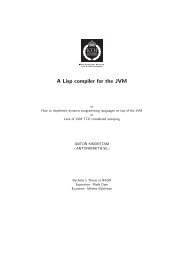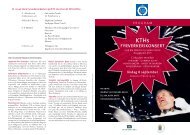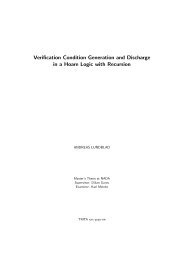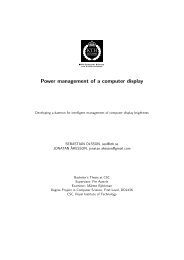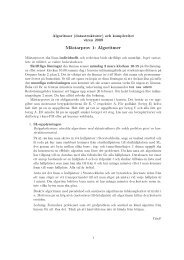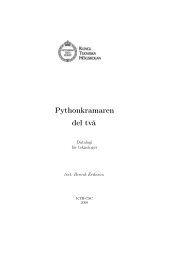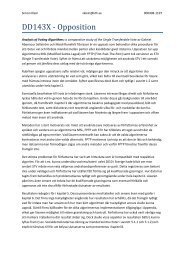The spectrum of delay-differential equations: numerical methods - KTH
The spectrum of delay-differential equations: numerical methods - KTH
The spectrum of delay-differential equations: numerical methods - KTH
You also want an ePaper? Increase the reach of your titles
YUMPU automatically turns print PDFs into web optimized ePapers that Google loves.
20 Chapter 2. Computing the <strong>spectrum</strong><br />
Definition 2.5 <strong>The</strong> matrix pair A, B ∈ C n×n is called simultaneously triangularizable<br />
if there is a regular S ∈ C n×n and upper triangular matrices TA and<br />
TB such that<br />
A = S −1 TAS and B = S −1 TBS .<br />
Assuming simultaneous triangularizability, we can introduce new variables ξ =<br />
Sx, such that system (2.7) can be written as a cascade <strong>of</strong> inhomogeneous scalar<br />
<strong>equations</strong><br />
˙ξj(t) = αjξj(t) + βjξj(t − h) + γj(t) ,<br />
where γj is a linear combination <strong>of</strong> the functions ξ1, . . . , ξj−1. <strong>The</strong> <strong>spectrum</strong> <strong>of</strong><br />
the whole system is the union <strong>of</strong> the spectra <strong>of</strong> these scalar <strong>equations</strong>. We thus<br />
obtain the most general case for the formula to hold.<br />
<strong>The</strong>orem 2.6 If A and B are simultaneously triangularizable, then (2.9) holds.<br />
Pro<strong>of</strong>: <strong>The</strong> characteristic equation is invariant under simultaneous similarity<br />
transformation i.e.,<br />
det(−sI + A + Be −sτ ) = det(−sI + TA + TBe −sτ ) .<br />
Moreover, the exponentiation operator and Lambert W commute with similarity<br />
transformation, i.e.,<br />
W (S −1 CS) = S −1 W (C)S .<br />
This implies that (2.9) is invariant under simultaneous similarity transformation<br />
<strong>of</strong> A and B. Hence we can assume without loss <strong>of</strong> generality that A and B are<br />
both upper triangular and apply Lemma 2.4. �<br />
We mention some interesting special cases.<br />
Corollary 2.7 If A and B commute, then (2.9) holds.<br />
Pro<strong>of</strong>: This follows from <strong>The</strong>orem 2.6 and the fact that commutativity implies<br />
simultaneous triangularizability (cf. [RR00]). �<br />
This result for τ = 1 is also stated (without pro<strong>of</strong>) in [CCH + 96]. It implies<br />
that (2.9) also holds in the pure <strong>delay</strong> case.<br />
Corollary 2.8 If A = 0 then σ(Σ) = � 1<br />
k σ( τ Wk(τB)) .




